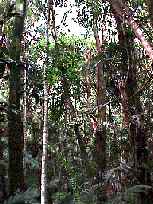Rainforest Understorey

Rainforest Understorey at
Chambers Wildlife Rainforest Lodges
The Understorey - The forest stratum between the forest floor and the canopy is called the understorey.
- It supports many plant species including the rainforest trees, ground ferns, tree ferns, zamias, cunjevois, cordylines or palm-lilies, native bananas, palms, climbing plants and epiphytes.
- Epiphytes (lichens, mosses, ferns and orchids) use trees for attachment purposes only, and do no hurt their host. Their roots absorb moisture from rainwater as it runs downs tree trunks, and nutrients from rotting vegetation trapped by the epiphytic structure itself or from crevices in the tree.
- Large tree branches in the understorey support many ferns such as the Bird’s Nest, Elkhorn, Staghorn and Basket Fern. These can reach great sizes and provide excellent catchment areas for falling leaves and plant debris. This rotting plant material then provides the fern with nutrients while supporting a miniature community of its own. Insects and other small creatures thrive in these damp aerial micro-habitats and frogs and reptiles commonly shelter within the foliage.
- Tropical rainforests in high rainfall and cloudy areas support the greatest abundance and diversity of epiphytic ferns, as most prefer shady situations beneath the canopy.
- Most orchids also grow in shady conditions as epiphytes in the understorey. There are about 150 species that have been recorded in the Wet Tropics, with at least 25percent of them being endemic to the region.
- Their brightly coloured flowers help attract insect pollinators such as wasps, bees, moths and butterflies. Many have similar structures – three inner petals and three outer sepals. Usually one petal is larger and acts as a landing platform for the pollinator.
- Hundreds of tree trunks of all shapes, sizes and colours can be seen in the understorey, their bark often decorated with epiphytic lichens and mosses giving it a mottled appearance. Trunks may be smooth, ridged, furrowed or noticeably bumpy.
- There are also many palm trees that are found in the Wet Tropics, several of them endemic. One is the Atherton Palm found only in rainforest above 800m altitude, and another is the majestic palm found only in dense upland regions.
- The Lawyer Vine (Wait-a-While) is a palm without a large woody trunk. It is a climber with long wiry stems that have hooks growing out and upward from axils of the leaves to help grip as a climbing aid.
- There are many other climbing plants that can be seen in the understorey too. The seeds of climbing plants germinate on the forest floor, and the successful seedlings grow up (with the support from a host tree) towards the light they need to survive until maturity.
- Many animal species are supported by the diversity of plant life in the understorey. Some of the understorey invertebrates are moths, butterflies, bees, ants, flies, preying mantids, stick insects, beetles, crickets, cicadas and spiders. These are preyed upon by skinks, geckos, monitors and birds (eg. robins, fantails, scrubwrens, gerygones, shrike-thrushes and treecreepers). Other birds such as pigeons and bowerbirds build their nests in sites amongst the understorey.
|
